7/1/2022
Highlights From CAST
Chris Beytes, Jennifer Zurko, Bill Calkins & Osvaldo Cuevas
Each year, there’s talk that the California Spring Trials have passed their peak, run the course, jumped the shark and now it’s time to move on to some form of new variety event that’s less costly, more efficient and timed better for a large number of people to attend.
Then you get to California and you visit your first greenhouse of the day and you’re overwhelmed with the pleasure of seeing so many plant people gathered in one spot doing what we all love: talking plants! The pandemic taught us that Zoom presentations are a meager substitute for the real thing. And even if the number of exhibitors and attendees is down, say, 50% (our guess) from the peak of 10 or 15 years ago, there’s still no replacement for looking at live plants in real greenhouses and hearing about their attributes from the experts.
That said, if you weren’t one of the 800 or so people able to make the trip to California this year, fear not! Ball Publishing has worked diligently since April to bring the Trials to you. During the event, there was our daily newsletter coverage and 30 YouTube videos featuring the highlights of nearly every trial location (find it all at californiatrials.com).
Now, we go more in-depth with written and photographic coverage of the most-talked-about varieties from the Trials. Granted, it’s not the same as being there (no fish tacos!), but we hope all these resources are the next best thing. If you want to make the trip next year, jot down the dates now so you can plan ahead: Wednesday, March 29 to Sunday April 2, 2023.
The Year of the … Dianthus
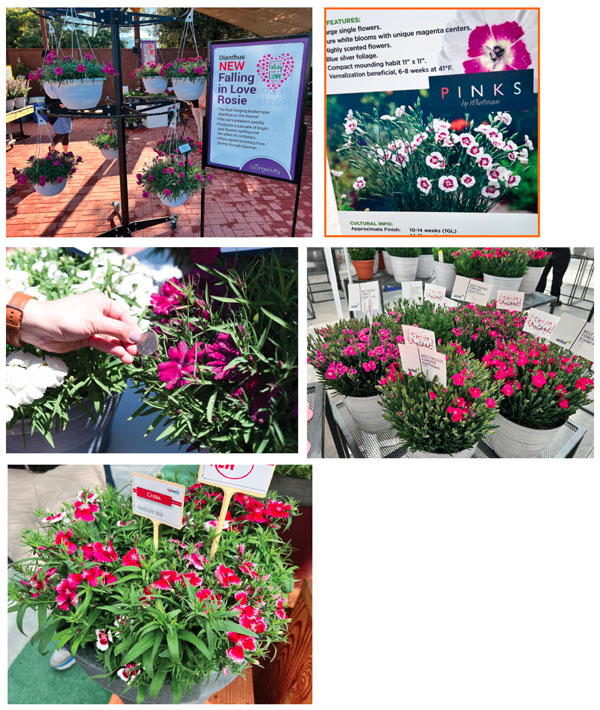 Boy, did we see a lot of dianthus! We don’t know if it was the most-introduced crop or not (in fact, we’re sure it was beat out by petunia and calibrachoa), but dianthus seems to be on every breeding company’s radar. Here are some favorites.
Boy, did we see a lot of dianthus! We don’t know if it was the most-introduced crop or not (in fact, we’re sure it was beat out by petunia and calibrachoa), but dianthus seems to be on every breeding company’s radar. Here are some favorites.
Falling in Love Rosie (Ball Ingenuity)
A hanging basket dianthus with a true cascading habit. The rose-colored blooms will keep up throughout the spring and summer. This crop can be started in the fall, grown cool through the winter to flush in spring, or finished nicely from an early spring start. It’s just a solo color for now, but they say more are coming.
American Pie Berry a la Mode (PlantHaven)
Large, single, pure white blooms with magenta centers and silver-blue foliage. (Unfortunately, we had to work from a photo, as the plants weren’t quite in flower yet).
Coronet (PanAmerican Seed)
Two new colors in PanAm’s large-flowered seed series: Purple and White Purple With Eye.
Best Friends Forever (Westhoff)
There are six different colors in this new series that Westhoff says will not fade. We admired its tidy, upright habit with lots of blooms covering almost the entire canopy of the plant.
Chiba Auricula Mix (Hem Genetics)
An interspecific dianthus blending barbatus and chinensis blood, the blooms feature dark and light pink colors with white tones.
Memorable Intros
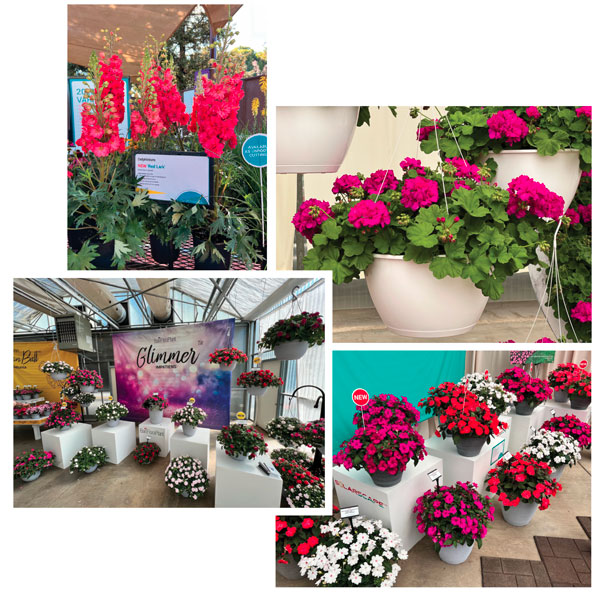 Delphinium Red Lark (Darwin Perennials)
Delphinium Red Lark (Darwin Perennials)
Yes, this is a perennial. But we were so struck by the amazing color on the blooms we had to call it out. This hybrid is stunning, with rich coral-red flower spikes that are sterile, so they continue to bloom in the garden. Enjoy them as is or enjoy the strong stems in a vase. Grows in Zones 5a to 8b.
Geranium Calliope Cascade (Syngenta)
Syngenta’s hot Calliope interspecific geranium collection gets another new subseries, Calliope Cascade. You can guess that it’s bred for baskets, but what’s interesting is just how much the foliage looks like an ivy geranium and just how much the flowers do NOT look like an ivy geranium—they’re traditional zonal flowers. The new series starts with just one color, Violet, but they assure us more are in the pipeline. If it performs like the other Calliopes, this could be a winner for baskets.
Impatiens Glimmer series (Ball FloraPlant)
Glimmer is a significant intro because it’s the world’s first IDM-resistant double impatiens. It has the beautiful look of BFP’s venerable Fiesta double impatiens, but with the same “high resistance” to IDM as PanAmerican Seed’s Beacon series. Glimmer starts with seven colors: Salmon, Apple Blossom, White, Burgundy, Dark Red, Bright Red and Hot Pink. The Fiesta series will go away, although they’ll retain some of the novelty colors until those come to Glimmer.
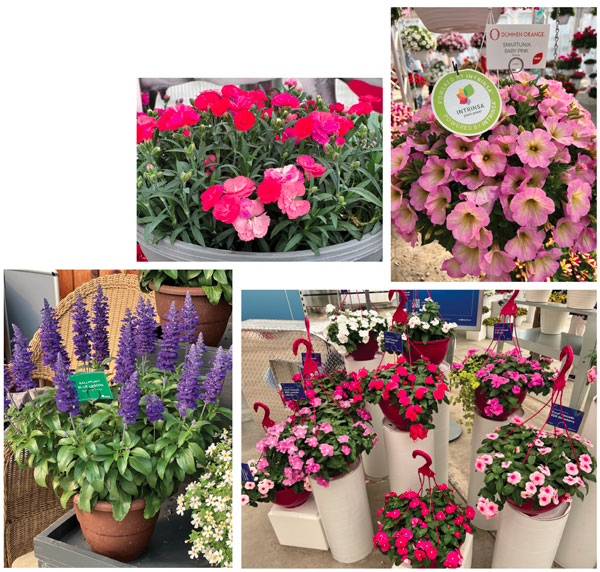 Impatiens Solarscape (PanAmerican Seed)
Impatiens Solarscape (PanAmerican Seed)
The first interspecific sun-loving impatiens from seed! Solarscape has been in the breeding pipeline for more than a dozen years, they say, and is now a reality. Think about it—a hybrid impatiens that can be economically produced to fit opening price point positions at retail in a variety of sizes, from jumbo packs and quarts to gallons and patio pots. The series launches with five colors, Neon Purple, Magenta Bliss, Orange Burst, White Shimmer and XL Salmon Glow. Great for in-ground use in full sun or part shade.
Dianthus Constant Cadence Potpourri (Green Fuse)
The Cadence series is known for interesting colors, but this variety really takes the festively frosted cake. The blooms open in multiple colors, including pink, rose and orange on one plant—in fact, each bloom can have multiple colors within the petals! The variety looks like a mix, but it’s not.
Petunias Smartunia (Dümmen Orange)
This eight-color, medium-vigor series touts Tobacco Mosaic Virus resistance thanks to “Intrinsa.” What’s Intrinsa? In a nutshell, it’s using gene mapping to identify desirable traits that already exist within the genus or species, then taking advantage of those traits through traditional breeding techniques. It’s called “predictive breeding” because if you know the genes you have, you can predict the traits your new variety will have. It speeds up the breeding process because you can test for the desirable genes when the plant is still tiny instead of having to grow it out to look for or test for the desirable trait. Dümmen says by 2025 all their petunias will be TMV-resistant, thanks to Intrinsa. They’ve already used it to create white rust-resistant mums and powdery mildew-resistant kalanchoes (coming soon).
Salvia Sallyfun Blue Lagoon (Danziger)
Salvia farinaceae Blue Lagoon, part of Danziger’s Sallyfun series, is drought tolerant and pest-free with no deadheading needed—the plants look as fresh in October as they do in May. Blue Lagoon has big, rich blue flowers that would look good in a bed, solo pot or combination.
Vinca Cora Cascade Upgraded to XDR (Syngenta)
There are no new colors in the series, but there’s important news: The whole Cora Cascade series—all 11 colors—is now “XDR’d”—meaning it’s got Syngenta’s “extreme disease resistance” rating against aerial phytophthora, the same as the original upright Cora vinca series.
Brand New Series
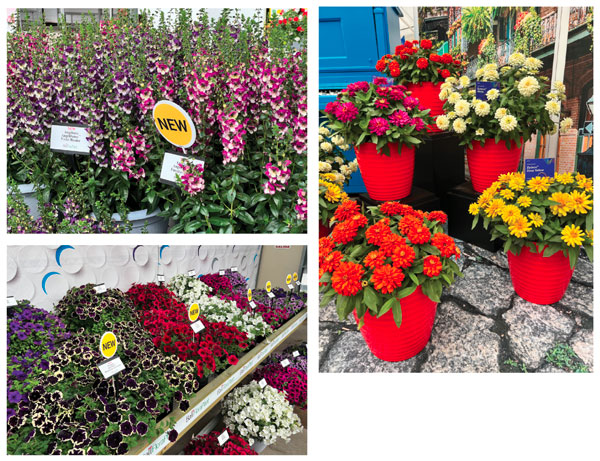 Angelonia Angel Dance (Ball FloraPlant)
Angelonia Angel Dance (Ball FloraPlant)
Angel Dance, which kicks off with two bicolors—Fuchsia Bicolor and Violet Bicolor—is 20% larger than the Archangel series. It’s heat-, humidity- and drought-tolerant with a classic garden look that the folks at BFP call “whimsical cottage.”
Petunia Sure Shot (Ball FloraPlant)
Sure Shot a medium-type petunia, fitting between their CannonBall (roundy-moundy) and ColorRush (spreading) series. It’s positioned for baskets and launches with six uniform colors: Blue Vein, Blueberries & Cream, Dark Blue, Dark Red, Magenta and White.
Zinnia Zydeco (Syngenta)
A marylandica type with fully double flowers that Syngenta say are 25% larger than others on the market. Four colors in this seed series, which finishes nine to 10 weeks from planting. Heat-, drought- and mildew-tolerant.
Begonia Hula (PanAmerican Seed)
This new series is an interspecific begonia that is said to have somewhat spreading habit, growing more outward than upward. It’s daylength neutral, so early to flower and fast to finish—just four to five weeks in packs, they say. The series starts with four colors: Pink, Blush, Red and Bicolor Red White.
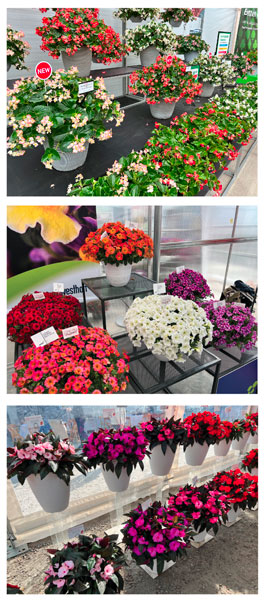 Petunia Flower Showers (Westhoff)
Petunia Flower Showers (Westhoff)
A trailing, basket-type collection with six colors to start. Two (Mayan Sunset and Patrick Star) come from the Crazytunias. Joining them are Flame, Golden Harvest, White and Ziggy Star.
New Guinea Impatiens Megaguinea (Dümmen Orange)
This series launches with four colors (Purple, Pink, Orange and White Blush), which Dümmen says you can produce using only one cutting per gallon pot, whereas most other series recommend three cuttings in that size pot; this series was developed to reduce input cost and still result in great plants. And they’re fast—eight weeks to finish from a rooted cutting.
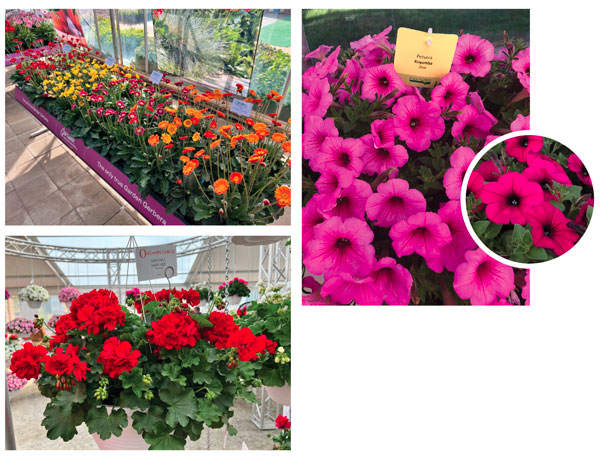 Gerbera Cheeky (HilverdaFlorist)
Gerbera Cheeky (HilverdaFlorist)
We liked the new Cheeky subseries of Garvinea garden gerberas from HilverdaFlorist, because it has loads of small flowers on vigorous plants. Cheeky gets four colors—Red, Yellow, Magenta and Orange—and is Zone 7-hardy.
Geranium Santana (Dümmen Orange)
There are several interspecific geranium series on the market, including class leader Calliope, but Dümmen feels they’re bringing something new to the table with Santana. The key message here is extreme uniformity in habit and timing across the entire seven-color series. All colors, even the White and Splash colors, time the same, with no PGRs needed, creating a uniform medium-vigor series.
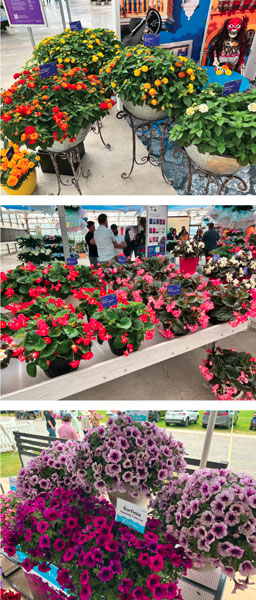 Petunia Kayamba (Kientzler)
Petunia Kayamba (Kientzler)
We were told “kayamba” means “strong” in some African dialect (although we couldn’t confirm that). Kayamba is bred for the landscape, with a “dense, but vigorous” habit. It’s not daylength neutral, but it’s early, said to be able to be in bloom by March. Six colors: Red, Pink, Blue, Purple, White, Pink Vein.
Lantana Bandolista (Syngenta)
This form of lantana is what Syngenta calls a “soft trailer” because of its semi-trailing, mounding habit. They’re vigorous, but they don’t get as big as the standard landscape types. Three out of the four colors are sterile (Coconut is not).
Petunia Surfinia Heavenly (Suntory)
This sub-series of the well-known Surfinia series features semi-trailing plants with uniform vigor, habit and timing across the four colors—Amethyst Burst, Cabernet, Blue and Deep Red.
Begonia Bionic (Syngenta)
These are big seed begonias suitable for gallon pots and larger, with substantial foliage and big flowers, as well as a controlled habit. They come in green- and bronze-leaf types with red and rose blooms.
Other Notable & A+ Additions
Petunia Headliner Strawberry Sky, Light Pink Sky (Selecta One)
Selecta One’s Headliner Strawberry Sky exhibits the white-spotted star pattern of the Skies beautifully. We were told that Selecta has been working to stabilize and enhance the star pattern to make it more dependable and less influenced by growing conditions, like the original Night Sky was. In addition to Strawberry, there’s also a Light Pink Sky and an improved Pink Sky 23.
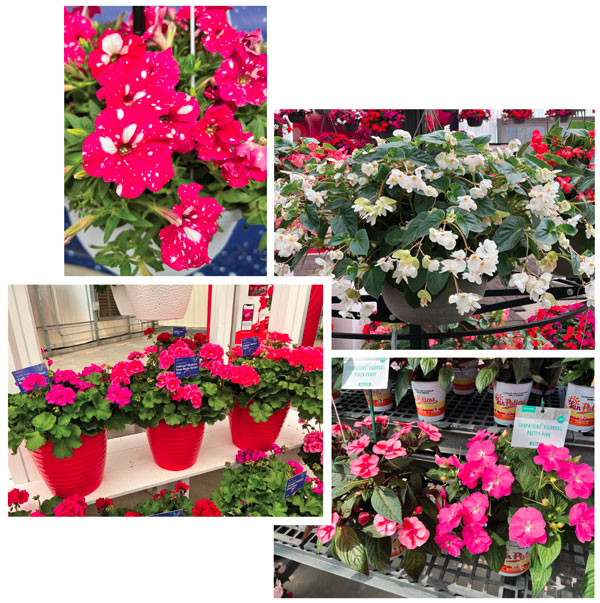 Begonia Dragon Wing White (PanAmerican Seed)
Begonia Dragon Wing White (PanAmerican Seed)
PanAm’s most significant begonia intro for 2022 is Dragon Wing White, which joins the original Dragon Wing Red and Dragon Wing Pink. If it performs like its siblings, it’ll be a winner.
Geranium Calliope Medium Salmon, Medium Bright Rose (Syngenta)
One of Syngenta’s most important annual crops, the Calliope interspecific geranium line gets two new colors in the Medium (original) series: Medium Salmon and Medium Bright Rose. Salmon lends a bright and light component to the series. Also, Medium Rose Mega Splash has been improved.
SunPatiens colors (Sakata)
We all know and love SunPatiens, which gets four new Compact colors (Purple Candy, Lavender Splash, Classic White, Lilac Improved) and two new Vigorous colors (Peach Candy, Pretty Pink).
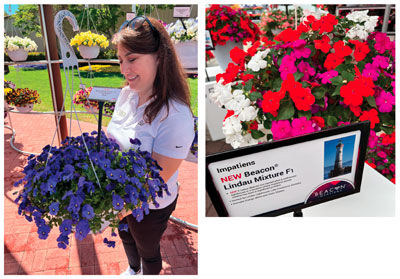 Pansy Cool Wave Blue (PanAmerican Seed)
Pansy Cool Wave Blue (PanAmerican Seed)
A new color in the trailing basket series of the Wave Pansy family, shown off by Ball’s Katie Rotella.
Impatiens Beacon Mixes (PanAmerican Seed)
When PanAm introduced the Beacon series of impatiens with high resistance to Impatiens Downy Mildew, it was truly a gamechanger. One of the common requests they received from growers around the world was for more mixes. New for the 2023 season are three 3-color mixes, all named for lighthouses—to stay within the “beacon” theme, of course: Lindau, Sanibel and Portland.
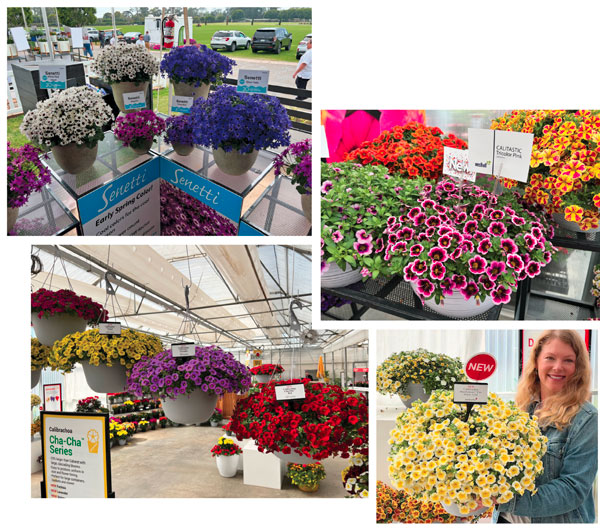 Pericallis Senetti White Red Heart, Blue Halo (Suntory)
Pericallis Senetti White Red Heart, Blue Halo (Suntory)
White Red Heart has bright white flowers with deep red centers—we think it’d be great for Valentine’s Day. Blue Halo has a rich blue flower, a dark eye and a white halo around that eye.
Calibrachoa Chameleon & Calitastic (Westhoff)
The German plant breeder offers some of the flashiest color patterns you’ll see in any calibrachoa line. They’ve got the Chameleons, which feature exciting multicolors (new is Pink Splash), and Calitastic, the more typical calibrachoa. New colors in Calitastic include Tricolor Pink, Bright Red, Merry Cherry and Violaceous.
Calibrachoa Cha-Cha (Ball FloraPlant)
Cha-Cha, BPF’s biggest series (25% bigger than Cabaret, they say) gets six new colors: Fuchsia, Lavender, Orange, Red, Red Kiss and Yellow.
Calibrachoa MiniFamous Uno & NEO (Selecta One)
Selecta is one of the pioneers in calibrachoa, with so many great MiniFamous colors. To simplify their offerings, they recently created two MiniFamous categories: Uno and Neo. Uno are compact, Neos are more vigorous. New in Uno this year are Orange+Red Vein and White Gold (modeled by Becky Lacy). Neo, meanwhile, gets Double White.
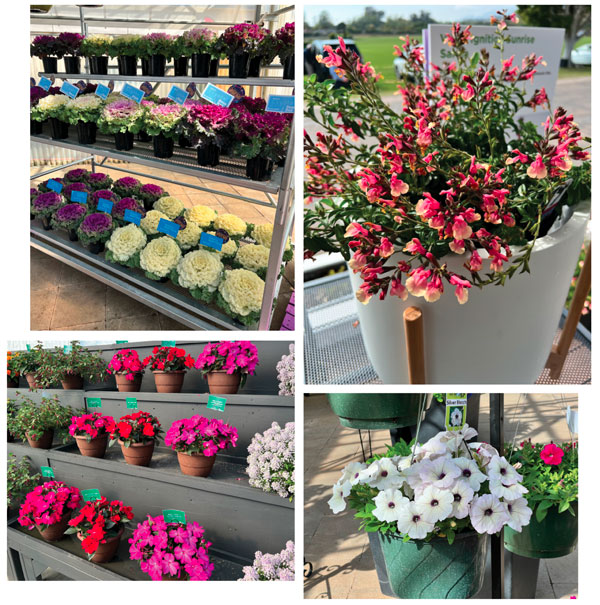 Ornamental Kale Crystal, Kamome (Takii)
Ornamental Kale Crystal, Kamome (Takii)
Takii is one of the kings of the brassicas, and they showcased two new introductions in ornamental kale this year, Crystal and Kamome. Crystal is fringed, and adds Deep Red and Pink. Kamome is more frilly; its new colors are Bright White and Bright Red.
New Guinea Impatiens Sol Luna (Danziger)
Danziger’s Sol Luna series of hybrid impatiens gained a few nice colors. Electric Pink, Red and Ultra Violet will be good choices for smaller containers, like 306-packs, and you can grow them with no PGRs and still make a uniform crop.
Salvia Vibe Ignition Cranberry, Sunrise (PlantHaven)
The two new additions to the Vibe Ignition collection brings the total to five. These are intended for gallon or larger production; the flexible flower stems lessen the risk of damage during shipping. Pictured is Sunrisea—quite the unusual color, eh?
Petunia Opera & Trilogy (Takii)
Opera, the low-spreading petunia, adds Rose; while Trilogy, which is more mounding and spreading, gains Silver Blotch, which has an almost-white flower with dark purple to black centers.
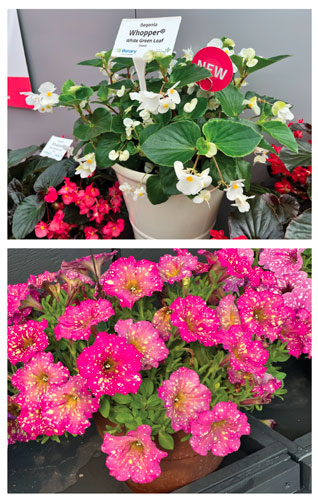 Begonia Whopper White Green Leaf (Benary)
Begonia Whopper White Green Leaf (Benary)
The first white for the Ball Seed-exclusive series of large landscape interspecific begonias.
Petunia Splash Dance (Danziger)
These are Danziger’s speckled-flowered petunias with the special gene (which they license) that results in spotted patterns. This year, they showed five new ones—Moonwalk, Calypso Cherry (pictured), Rumba Rose, Violet Vogue and Fuchsia Flamenco. GT